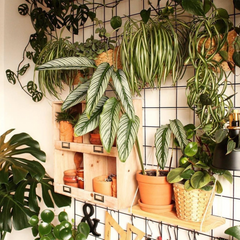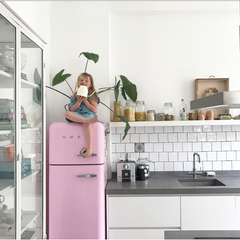By now you've probably figured out that plant-parenthood isn't as easy as it first seems. You give your green amigo all the light and water it needs and it's still not thriving. And hey, is that a yellow leaf? But I just watered it yesterday! Should I be using fertilizer? all seems so simple but how do you get your new green friend to thrive, and why do you keep killing your old green friends!? We are often surprised when we see brown or yellow leaves after getting a new green roommate. Didn't you just water it yesterday? And what are those black and white spots doing on the leaves! Yuck! Aphids and critters, how to get rid of them?
The amount and temperature of the water, the occurrence of illnesses, the amount of plant fertilizer and when to repot your plants. Here, all of this will be covered. Finally, all you wanted to know about the care for plants!
Sun, shade, partial shade
Okay, seems simple right? The differences between sun and shade are obvious but what do we mean with partial shade? Grab your notebook and let us explain!
Partial shade
What does partial shade mean? How far from the window do you need to put plants that prefer partial shade? Usually about 2 to 3 metres from the window sill works fine. Partial shaded plants don't mind some rays of sunshine for two to three hours but prefer bright spots that are not in direct sunlight most of the day.


Sun
Seems obvious right? Well there are a few things you need to know about plants that like full sunlight. Typically don't put them farther than 2 metres away from the window. A south-facing window works best but east- or west-facing works too. Also note that plants that like full sunlight are still typically grown in nurseries. They have not yet adjusted to bright sun conditions so put these plants a little farther away from the window at first and slowly move them closer.
Shade
You may not know this, but when a plant likes a shaded environment, this does not mean you have to put them in the full shade all the time. it is all about light intensity and these plants like a low-light intensity but they still need light to survive. 3 metres away from a window is perfect for them.
Drip...drip...drip
Water, your green friend can't live without it! To prevent your plant from getting ill, you will have to make sure your plant gets enough, but not too much, water. The right water also matters. Are you used to giving plants water straight from the tap? Some plants prefer filtered water. Do you provide cold or lukewarm water? Plants can get a 'shock' from water that is too cold. When in doubt, use lukewarm water. Plants like it at room temperature. Yummm, let it rain!
Oh and one more thing, the amount of water is paramount. Most plants die because they get too much, not because they get too little. Proper drainage plays a large part here, too. When pots have standing water in the bottom of the pot, your plant will eventually develop root rot which is hard to overcome and kills your plants. So how much water does your plant really need? Checking how moist the soil is, is a good way of finding out. A lot of plants prefer a slightly moist soil. If you stick your finger deep into the soil and it comes out dry, it is time to water your plant. Still wet? Wait a few more days. Anyway, every green amigo has his/her own watering needs. If you want to nail it on the head, use our App!
>Want some more plant watering tips? Check out our blog, all about watering!


@stylestek @fotostudio.beervelde
Plant fertilizer
Plants looooove food. Did you know that? Granted, moderation is key when it comes to plant food but most plants do need some to grow properly. Just water isn't enough in most cases. There are exceptions such as the Snake plant which does not like plant food at all (nice!). Plants that do like plant fertilizer will typically prefer it in summer with very little to no food in winter when they are in hibernation mode. To prevent yourself from giving too much fertilizer, use the app! The app will tell you exactly when and how much fertilizer to give your plants.
Vermin and pests
There are so many causes of vermin in plants that it is hard to mention them all. Your four legged roommates may bring them in from outside, drafts can cause them or you may have some on your coat as you are walking in. For that reason it is especially important to study your plants very often. Check underneath the leaves and if you do find any critters, try washing them away with lukewarm water before trying anything more nuclear. When all else fails - repot your green amigo!
>Found some pests on your plant? Check out our plant illness care guide!
Repotting
Most plant parents never repot their plants. It isn't necessary but if you want your plants to grow and thrive, repotting is an essential tool in your plant parenthood toolkit. Nurseries typically put their plants in smaller pots to keep transport costs low. So free your plant from its small home as soon as possible!
>Hey, repotting is hard work. Check out our blog to learn all about repotting!
We hope that these tips helped! If you do end up having more questions, do not hesitate to ask our customer service team at hello@plantsome.ca. If you want more inspiration, check out our Facebook and Instagram!





